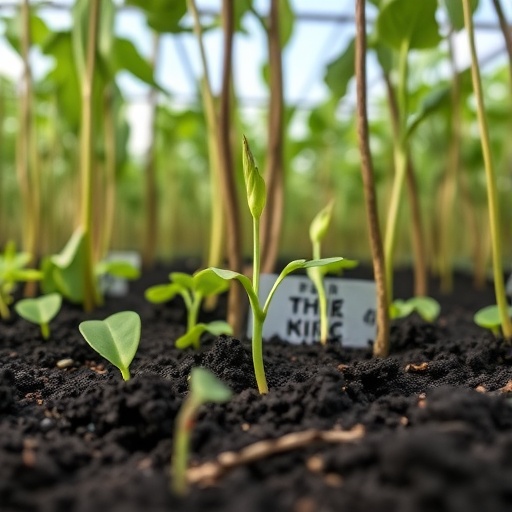A groundbreaking review published in the leading journal Biochar X has unveiled transformative advances in the modification of biochar using iron, positioning this engineered material as a cornerstone for future environmental remediation and sustainable agricultural practices. The convergence of carbon-rich biochar with iron functionalization represents a quantum leap in the capability to purify polluted environments while enhancing soil vitality and carbon sequestration.
Biochar, a porous carbonaceous solid derived from the pyrolysis of biomass under oxygen-limited conditions, has long been lauded for its environmental benefits. However, its intrinsic surface chemistry and porosity have traditionally restricted its full potential in trapping pollutants and catalyzing remediation pathways. Researchers are now overcoming these constraints by incorporating iron particles into the biochar matrix, fundamentally altering its physicochemical properties and unlocking powerful new functionalities.
Iron’s role as a transition metal with versatile redox states makes it an ideal candidate for biochar functionalization. When embedded within the carbon lattice, iron promotes the creation of reactive sites that facilitate electron transfer reactions essential for pollutant degradation and binding. This synergy elevates biochar’s capacity to adsorb a range of contaminants including heavy metals such as arsenic and chromium, as well as organic pollutants like pesticides and synthetic dyes.
What sets iron-enhanced biochar apart is its ability to engage in advanced oxidation processes (AOPs). Within aqueous environments, iron acts as a catalyst to generate reactive oxygen species through redox cycling, accelerating the breakdown of persistent organic pollutants that conventional treatment methods fail to dismantle efficiently. This catalytic behavior opens promising avenues for wastewater treatment technologies seeking to meet stringent environmental standards.
Equally significant is the improvement in biochar’s structural attributes imparted by iron modification. The inclusion of iron nanoparticles increases the surface area and modulates surface charge, features that amplify adsorption kinetics and specificity toward a diverse array of pollutants. Enhanced porosity ensures greater interaction between the biochar and contaminants, facilitating more effective remediation in both soil and aquatic systems.
The versatility of iron-functionalized biochar extends beyond pollution control into sustainable agriculture. By stabilizing nutrients such as phosphate within the soil matrix, this material acts as a slow-release fertilizer, improving nutrient use efficiency and minimizing runoff that contributes to eutrophication. Moreover, its carbon-rich composition supports soil health by enhancing texture, water retention, and microbial activity, forming a resilient foundation for crop growth.
The pathways for synthesizing iron-modified biochar have diversified, including co-pyrolysis of biomass with iron salts and post-pyrolysis impregnation techniques. Emerging green synthesis methods that employ environmentally benign reagents and processes promise scalable and eco-friendly production. Researchers can fine-tune iron particle size, distribution, and oxidation state, tailoring the material’s performance to specific environmental challenges.
Innovative applications are emerging at the intersection of material science and environmental engineering. Iron-enhanced biochar shows promise for integration into energy storage devices, leveraging its conductive properties and redox activity. Smart environmental sensors incorporating iron-biochar composites could provide real-time monitoring of soil and water quality by detecting changes in redox conditions or pollutant concentrations, advancing precision environmental management.
Despite these leaps, challenges remain in translating laboratory successes into field-scale solutions. The aging behavior of iron species within biochar under dynamic environmental conditions is not well-understood, raising questions about long-term stability and performance. Additionally, transformations in iron chemistry over time could alter pollutant binding and necessitate comprehensive spectroscopic investigations.
Standardized testing protocols and coordinated field trials across diverse geographical and ecological settings are urgently needed to assess environmental safety, economic feasibility, and operational scalability. Interdisciplinary collaboration among chemists, soil scientists, environmental engineers, and policymakers will be critical to bridge the gap between innovation and practical implementation.
The promise of iron-functionalized biochar aligns with broader goals of a circular bioeconomy by valorizing waste biomass and transforming it into high-value remediation agents. This aligns with global shifts toward resource efficiency and sustainability, positioning iron-biochar as a multifunctional material addressing urgent challenges in water quality, soil health, and climate change mitigation.
Dr. Shahidul Islam, leading the research efforts, emphasizes the necessity of integrating environmental safety assessments alongside functional innovations. “Developing novel materials is only part of the solution; ensuring they are safe and economically viable is essential for real-world impact,” he said. Such holistic consideration will ensure iron-modified biochar plays a critical role in next-generation environmental technologies.
In sum, the comprehensive review reflects a pivotal moment in environmental science, where iron-functionalized biochar emerges as a powerful, adaptable, and sustainable material platform. Its multifunctionality extends from pollutant sequestration and catalysis to agricultural enhancement and environmental sensing, holding the potential to revolutionize how humanity addresses pollution and sustains ecosystem services in the twenty-first century.
Subject of Research: Not applicable
Article Title: Advances in biochar modification for environmental remediation with emphasis on iron functionalization
News Publication Date: 5-Nov-2025
Web References: http://dx.doi.org/10.48130/bchax-0025-0010
References: Zhang Y, Chen H, Islam S. 2025. Advances in biochar modification for environmental remediation with emphasis on iron functionalization. Biochar X 1: e009
Image Credits: Yue Zhang, Hao Chen & Shahidul Islam
Keywords: Carbon, Iron, Environmental remediation, Environmental management, Adsorption, Pollutants, Waste management, Sustainable agriculture
Tags: biochar modification advancementscarbon sequestration methodsenvironmental remediation techniquesheavy metal adsorptioniron-functionalized biocharpollutant degradation strategiespollution control innovationspyrolysis of biomassreactive sites for contaminant bindingsurface chemistry of biocharsustainable agriculture practicestransformative environmental technologies





